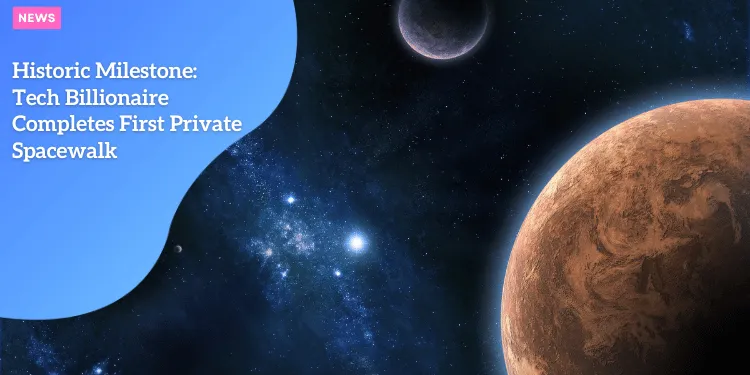Historic Milestone: Tech Billionaire Completes First Private Spacewalk

Anúncios
Tech billionaire Jared Isaacman made history by completing the first private spacewalk, stepping out from a SpaceX capsule high above Earth.
This groundbreaking event wasn’t just a solo effort.
SpaceX engineer Sarah Gillis also took part, showcasing the collaborative spirit of this mission.
Conducted hundreds of miles above the Earth, this monumental achievement signifies an exciting milestone in commercial space travel.
The People Behind the Mission
Jared Isaacman, founder of Shift4 Payments, isn’t new to spectacles of this kind.
His partnership with SpaceX and willingness to push boundaries made this historic spacewalk possible.
Joining him, Sarah Gillis brought her technical expertise to ensure the mission’s objectives were achieved.
Significance of the Event
This mission holds more weight than just a bold statement. It was a part of a five-day adventure primarily funded by Isaacman and supported by SpaceX.
The mission’s central goal was to test SpaceX’s new spacesuits.
These aren’t your everyday suits; they have been designed for flexibility and mobility to help future astronauts perform better in space’s demanding environment.
Stepping Out into History
The spacewalk itself was comparatively brief, lasting just under two hours.
Unlike NASA’s extended operations, which often stretch for seven to eight hours, this shorter duration focused on the basics.
The participants remained close to their capsule, ensuring tether safety while assessing the suits’ flexibility and movement.
A Pioneering Milestone
This event marks an important step forward for the commercial space industry.
It highlights the increasing role of private funding and the relentless pursuit of technological advancement by companies like SpaceX.
More importantly, it opens up the dream of experiencing a spacewalk to private citizens, possibly revolutionizing space tourism.
As the space industry continues to evolve, this historic mission serves as an inspiring example of what private funding and innovation can achieve, laying the groundwork for what’s yet to come.
Mission Details and Objectives
One of the significant aspects of this historic spacewalk was its integration into a broader five-day mission funded by Jared Isaacman and SpaceX. This journey wasn’t merely about floating in weightlessness; it had key objectives focused on testing and validating new technology.
Testing the New Spacesuits
The main goal was to test the newly developed spacesuits by SpaceX.
These suits were designed with enhanced flexibility and mobility in mind, differing from the bulkier designs of traditional spacesuits.
This was crucial since the primary focus was to ensure astronauts could move more freely and comfortably while performing basic tasks in space.
Brief but Intensive Spacewalk
While traditional NASA spacewalks can stretch up to seven or eight hours, Isaacman’s and Gillis’s exploration lasted under two hours.
The emphasis was on short, effective movements rather than prolonged excursions.
They concentrated on bending, twisting, and stretching to examine how well the suits adapted to various motions.
The procedure involved simple, well-controlled maneuvers. Isaacman first stepped out, followed by Sarah Gillis after ten minutes.
Both remained tethered to their SpaceX capsule, maneuvering within the confined space to ensure security and control.
For instance, Gillis moved up and down in weightlessness, never straying far from the protective confines of the capsule.
Objectives Beyond the Suit Test
While the spacewalk was central, this mission also aimed to highlight the feasibility and safety of private space endeavors.
By demonstrating the successful use of SpaceX’s technology in a real-world scenario, it also aimed to pave the way for future missions that could include more complex tasks.
The focus now shifts towards the growing implications of these private ventures and how they could shape the future of space exploration.
Comparison to Traditional Spacewalks
The first private spacewalk marked a distinct departure from traditional spacewalks conducted by NASA.
Spacewalks typically undertaken by NASA astronauts are extensive, often lasting seven to eight hours.
These missions involve complex tasks such as repairs and maintenance across large areas of the International Space Station (ISS).
In contrast, the recent private spacewalk led by Jared Isaacman was notably shorter, clocking in at under two hours.
Shorter Duration
NASA spacewalks are known for their length and intensity, requiring astronauts to move across vast expanses of the ISS.
These extended periods necessitate thorough preparation and substantial physical stamina.
In contrast, the private spacewalk undertaken by Isaacman and SpaceX engineer Sarah Gillis was far more limited in scope and duration.
Lasting just under two hours, the primary focus was on testing the flexibility and mobility of the new SpaceX spacesuits rather than performing intricate tasks.
This brief yet significant outing was meticulously planned, emphasizing efficiency and safety.
Limited Movement
During traditional spacewalks, astronauts often navigate large sections of the ISS while tethered, performing critical repairs and experiments.
The private spacewalk was markedly different in this regard. Isaacman and Gillis remained tethered close to their capsule, limiting their movements significantly.
This approach reduced the risks associated with spacewalks, such as floating away, and allowed for a concentrated evaluation of the new suits.
The capsule provided a stable platform for the astronauts as they conducted simple yet vital stretching exercises to test the suits in a real space environment.
Focus on Testing and Stretching
Rather than engaging in elaborate procedures, Isaacman and Gillis focused on more straightforward, controlled actions.
The primary objective was to stretch and move within the confines of the new spacesuits.
This emphasis on basic motor functions served to evaluate how well the suits could accommodate human movement in microgravity.
By prioritizing these fundamental tests, the mission sought to gather crucial data on the suitability and safety of the new suits for future ventures.
This comparative approach underlines the evolving nature of spacewalks as they transition from exclusively government-led initiatives to include private endeavors.
The success of this mission illustrates the potential for streamlined, efficient spacewalks that focus on innovation and safety in the private sector.
Challenges and Achievements
Tackling Glitches Head-On
Even with meticulous planning, space missions are never without their challenges.
During the historic private spacewalk, Jared Isaacman encountered a minor hitch: the hatch, which was designed to open with a simple button press, had to be manually opened.
This unexpected task didn’t derail the mission but did highlight the necessity for quick problem-solving and manual dexterity even in highly automated environments.
Adding to the complexity, SpaceX engineer Sarah Gillis reported visible bulges in the hatch seal before heading out, a situation that required immediate attention to ensure safety.
Successful Testing of New Spacesuits
The overarching goal of this mission was to test SpaceX’s newly-developed spacesuits.
Both Isaacman and Gillis successfully demonstrated the suits’ capabilities.
Designed for flexibility and mobility, the suits performed remarkably under the harsh conditions of space.
Unlike traditional, cumbersome spacesuits, these newer models allow for a broader range of motion, which will be crucial for future missions that demand high physical activity levels and operational efficiency.
Highlighting Potential Hazards
Despite the mission’s success, the spacewalk exposed the inherent dangers of private space travel.
Space remains an unforgiving environment where minor issues can escalate rapidly.
The need to manually open the hatch, coupled with the bulging seal, illustrated the types of risks that astronauts—whether private or professional—face when venturing outside the relative safety of their capsules.
Additionally, tethering both Isaacman and Gillis close to the capsule was a conservative but prudent approach.
This method minimized exposure to open space hazards, reducing the risk of drifting away uncontrollably.
However, the brief taste of spacewalking has surely whetted the appetite for more ambitious future missions where such constraints may be less tenable.
With these initial hurdles overcome, the private space sector is now better equipped to tackle future challenges.
Significance for Commercial Space Industry
A Step Forward in Private Space Exploration
The recent private spacewalk marks an exciting milestone for the commercial space industry.
By successfully completing the first-ever private spacewalk, tech billionaire Jared Isaacman and SpaceX engineer Sarah Gillis have shown that private missions can take on previously uncharted territories.
This monumental event demonstrates that space is no longer the exclusive domain of government agencies and that private entities can contribute significantly to the advancement of space exploration.
SpaceX’s Technological Advancements
SpaceX continues to push the boundaries of space technology.
The mission’s success highlights the company’s innovative spirit, especially with the introduction of the new spacesuits designed for enhanced flexibility and mobility.
These suits not only had to withstand the harsh conditions of space but also had to demonstrate superior performance in a more streamlined environment.
The ability to perform a spacewalk with these suits underscores SpaceX’s ongoing commitment to developing cutting-edge technologies.
The Growing Role of Private Funding
The successful private spacewalk also emphasizes the increasing role of private funding in space missions.
Jared Isaacman’s financial contributions have paved the way for this mission, showcasing how private investment can drive substantial advancements in space technology.
This shift is opening new avenues for commercial activities in space, making opportunities for research, exploration, and even tourism more accessible than ever.
As we look to the future, the significance of this milestone cannot be overstated.
The achievements of Isaacman and Gillis lay the groundwork for an era where space missions are not just a national endeavor but a commercial one as well.
This transition creates a promising landscape for innovations and collaborations in space exploration.
Future Implications
Part of Isaacman’s Polk Program
This private spacewalk is only the beginning for Jared Isaacman’s ambitious Polk program.
By pushing the frontier of private space travel, Isaacman aims to conduct even more advanced and extended missions in the near future.
This program is planned to demonstrate a variety of technologies and systems essential for long-duration space missions, eventually paving the way for human exploration of Mars and beyond.
Potential for More Private Citizens to Experience Spacewalks
One of the most exciting aspects of these advancements is the potential for more private citizens to experience spacewalks.
What was once the exclusive domain of government astronauts may soon become available to a broader range of individuals.
With improved safety protocols and innovative technologies, space tourism is poised to enter a new era.
Prime candidates will undergo rigorous training and preparation, but imagining a future where stepping into space is an achievable dream makes the prospect electrifying.
Opening New Possibilities for Commercial Space Activities
This milestone also opens the door for numerous commercial space activities.
Companies outside of traditional aerospace industries could venture into spaces such as mining asteroids for precious resources, building space-based solar power plants, or creating space habitats for tourism and research.
The implications are endless and commercially viable space endeavors will only continue to expand as costs decrease and technology advances.
Isaacman’s successful mission and the involvement of SpaceX underscore the growing synergy between private funds and public interest in space exploration.
The ripple effects of these achievements will be felt across various sectors, bringing us closer to a future where space is truly accessible to all humankind.







